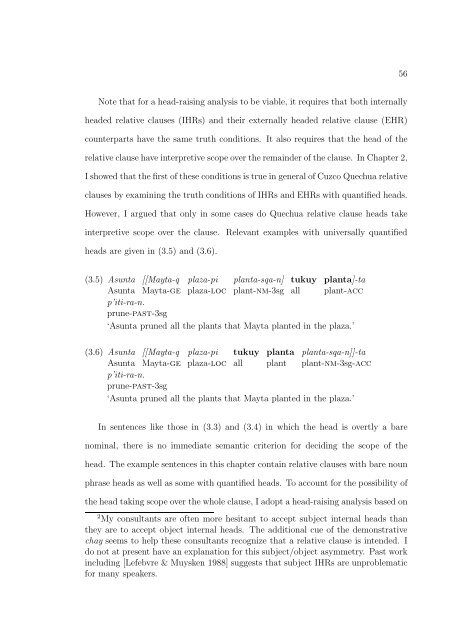the syntax and semantics of relativization and quantification
the syntax and semantics of relativization and quantification
the syntax and semantics of relativization and quantification
Create successful ePaper yourself
Turn your PDF publications into a flip-book with our unique Google optimized e-Paper software.
56<br />
Note that for a head-raising analysis to be viable, it requires that both internally<br />
headed relative clauses (IHRs) <strong>and</strong> <strong>the</strong>ir externally headed relative clause (EHR)<br />
counterparts have <strong>the</strong> same truth conditions. It also requires that <strong>the</strong> head <strong>of</strong> <strong>the</strong><br />
relative clause have interpretive scope over <strong>the</strong> remainder <strong>of</strong> <strong>the</strong> clause. In Chapter 2,<br />
I showed that <strong>the</strong> first <strong>of</strong> <strong>the</strong>se conditions is true in general <strong>of</strong> Cuzco Quechua relative<br />
clauses by examining <strong>the</strong> truth conditions <strong>of</strong> IHRs <strong>and</strong> EHRs with quantified heads.<br />
However, I argued that only in some cases do Quechua relative clause heads take<br />
interpretive scope over <strong>the</strong> clause. Relevant examples with universally quantified<br />
heads are given in (3.5) <strong>and</strong> (3.6).<br />
(3.5) Asunta<br />
Asunta<br />
[[Mayta-q plaza-pi planta-sqa-n] tukuy<br />
Mayta-ge plaza-loc plant-nm-3sg all<br />
p’iti-ra-n.<br />
prune-past-3sg<br />
‘Asunta pruned all <strong>the</strong> plants that Mayta planted in <strong>the</strong> plaza.’<br />
(3.6) Asunta<br />
Asunta<br />
planta]-ta<br />
plant-acc<br />
[[Mayta-q plaza-pi tukuy planta<br />
Mayta-ge plaza-loc all plant<br />
p’iti-ra-n.<br />
prune-past-3sg<br />
‘Asunta pruned all <strong>the</strong> plants that Mayta planted in <strong>the</strong> plaza.’<br />
planta-sqa-n]]-ta<br />
plant-nm-3sg-acc<br />
In sentences like those in (3.3) <strong>and</strong> (3.4) in which <strong>the</strong> head is overtly a bare<br />
nominal, <strong>the</strong>re is no immediate semantic criterion for deciding <strong>the</strong> scope <strong>of</strong> <strong>the</strong><br />
head. The example sentences in this chapter contain relative clauses with bare noun<br />
phrase heads as well as some with quantified heads. To account for <strong>the</strong> possibility <strong>of</strong><br />
<strong>the</strong> head taking scope over <strong>the</strong> whole clause, I adopt a head-raising analysis based on<br />
2 My consultants are <strong>of</strong>ten more hesitant to accept subject internal heads than<br />
<strong>the</strong>y are to accept object internal heads. The additional cue <strong>of</strong> <strong>the</strong> demonstrative<br />
chay seems to help <strong>the</strong>se consultants recognize that a relative clause is intended. I<br />
do not at present have an explanation for this subject/object asymmetry. Past work<br />
including [Lefebvre & Muysken 1988] suggests that subject IHRs are unproblematic<br />
for many speakers.
















